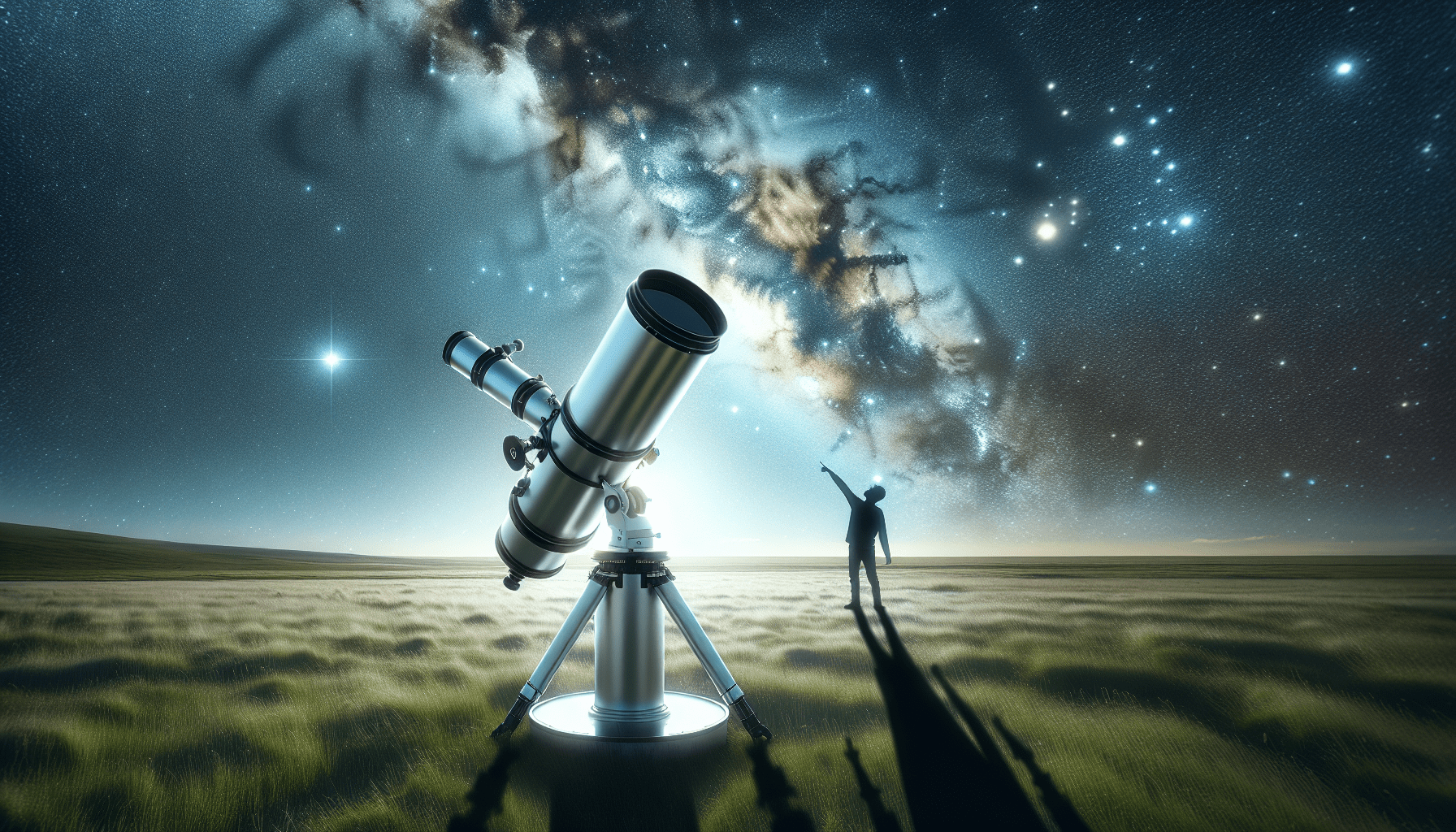A Beginner’s Guide to Setting Up a Telescope. Have you ever looked up at the night sky and wondered how to get a closer look at the stars, planets, and other celestial wonders? Setting up a telescope can open up a whole new world for you. Whether you are a budding astronomer or just curious about the universe, knowing how to properly set up a telescope can dramatically enhance your stargazing experience.
Table of Contents
A Beginner’s Guide to Setting Up a Telescope
Introduction
In this guide, you will find everything you need to know about setting up a telescope, from unpacking it to calibrating it for your first observation. This isn’t just a technical outline; it’s a journey that promises to turn your celestial curiosity into reality.
The Thrill of Stargazing
Stargazing has long fascinated humanity. Ancient civilizations built remarkable monuments aligned with the stars, and today, technology allows us to look deeper into space than ever before. If you have ever gazed up at the night sky and felt a sense of awe, you’re in good company. Modern telescopes can reveal the rings of Saturn, craters on the Moon, and even distant galaxies. Knowing how to set up your telescope properly will ensure you’re getting the best possible views. Let’s dive into this fascinating hobby together.
Why Should You Read This Guide?
Setting up a telescope isn’t as simple as pointing it at the sky and looking through the lens. There’s a process to follow, equipment to know, and techniques to master. This guide provides comprehensive, fact-based information to help you get started without feeling overwhelmed.

This image is property of pixabay.com.
Historical Context
A Brief History of Telescopes
The telescope has a rich history that dates back to the early 17th century. Invented by Hans Lippershey, the original design was a refracting telescope using lenses to magnify distant objects. Shortly after, Galileo Galilei improved on Lippershey’s design and was among the first to use a telescope for astronomy, discovering moons orbiting Jupiter and phases of Venus. Telescopes have evolved dramatically since then, paving the way for our deeper understanding of the universe.
Current Trends in Telescope Technology
Today, telescopes come in various types and sizes, featuring advanced technologies that make stargazing accessible to amateurs and professionals alike. The latest trend is computerized telescopes, which can automatically locate and track celestial objects.
Types of Telescopes
| Type | Description | Ideal For |
|---|---|---|
| Refracting Telescopes | Use lenses to gather and focus light. | Planetary and lunar observation. |
| Reflecting Telescopes | Use mirrors instead of lenses. | Deep-sky observation. |
| Compound Telescopes | A hybrid of refractors and reflectors. | Versatile all-around observation. |
Choosing the Right Telescope
choosing the right telescope is crucial. Reflectors are generally more powerful and suited for deep-sky observations, while refractors are easier to maintain and great for lunar and planetary views. Compound telescopes offer a balanced performance, often coming with computerized mounts for ease of use.

This image is property of pixabay.com.
Setting Up Your Telescope
Unpacking and Assembling
Unpacking your telescope should be done carefully. Ensure all parts are accounted for—tube, mount, eyepieces, and other accessories. Follow these steps to assemble:
- Mount: Position the mount firmly on the ground or a stable platform.
- Tube: Attach the tube to the mount as instructed in your manual.
- Eyepiece: Insert the chosen eyepiece into the focuser.
Balancing the Telescope
Balancing is crucial for stable observations:
- Counterweights: Place the counterweights on the mount’s arm. Ensure they balance the weight of the telescope tube.
- Declination and Right Ascension: Adjust using the fine-tuning knobs.
Balancing ensures smooth movement and reduces strain on the motors if you have a computerized mount.
Aligning Your Telescope
Aligning your telescope is vital for accurate tracking:
- Polar Alignment: Point your telescope towards Polaris (North Star) for equatorial mounts.
- Finder Scope: Calibrate the finder scope with the main telescope using a distant terrestrial object during the day.
- Calibration Stars: Use a couple of bright stars in the night sky to further align your telescope.
The Sky Tonight
Modern telescopes often come with an object database and computerized sky charts. Learning to navigate these can dramatically enhance your stargazing experience. An app or a star map can help you identify celestial objects and navigate using your telescope.
Focusing Your Telescope
Focusing is the final step. Start with low magnification eyepieces and gradually increase to higher magnifications:
- Coarse Focus: Adjust the primary mirror or lens.
- Fine Focus: Use the fine-tuning knob to sharpen the image.
Take your time when focusing; rushing can lead to blurry images.
Common Mistakes and Solutions
Misalignment Issues
Misalignment is a common issue that leads to poor-quality images. Ensure your finderscope and the main scope are aligned. Double-check your polar alignment if using an equatorial mount.
Understanding Magnification
Over-magnification is another pitfall. High magnification eyepieces can reduce image quality due to atmospheric distortion. Stick to lower magnifications for sharper images, especially if you’re new to stargazing.

This image is property of pixabay.com.
Case Studies
Example 1: Reflector Telescope
John, a novice stargazer, set up his 8-inch reflector telescope. Initially, he struggled with alignment. By diligently following the manual and consulting online forums, he finally achieved perfect alignment, enabling him to see Jupiter’s bands and the Great Red Spot with remarkable clarity.
Example 2: Refractor Telescope
Lisa uses a 90mm refractor telescope mainly for lunar and planetary observations. After a few sessions, she mastered the art of focusing and balancing her scope, making Saturn’s rings and lunar craters appear crisp and vivid.
Various Points of View
Manual vs. Computerized Telescopes
| Feature | Manual Telescopes | Computerized Telescopes |
|---|---|---|
| Ease of Use | Requires knowledge of the night sky | More user-friendly |
| Cost | Generally less expensive | More expensive due to advanced tech |
| Setup Time | Longer setup and learning curve | Quick setup with automated alignment |
| Observation Quality | Dependent on user skill | Generally consistent high-quality views |
Both manual and computerized telescopes offer unique experiences. While manual telescopes require a deeper understanding of astronomy for excellent results, computerized ones provide a more effortless experience, often at a higher cost.

Impact Assessment
Manual Telescopes
Manual telescopes can provide a richer understanding of the night sky. The time invested in learning star charts and alignments pays off with a fulfilling stargazing experience. For students and enthusiasts, this hands-on approach can deepen their appreciation and knowledge of astronomy.
Computerized Telescopes
Computerized telescopes democratize stargazing, making it accessible to a broader audience. They significantly reduce the learning curve and allow users to focus on observation rather than setup. This ease of use can encourage more people to take up astronomy.
Future Directions and Implications
Predicting the Future of Telescope Technology
As technology evolves, telescopes will continue to become more accessible and powerful. Future advancements may include enhanced imaging capabilities, integrated AI for better object tracking, and even augmented reality interfaces to guide your stargazing sessions.
Implications for Amateur Astronomy
The increasing availability of sophisticated yet user-friendly telescopes can significantly impact amateur astronomy. More people will participate in stargazing activities, potentially leading to greater public interest in science and astronomy. This increased engagement could drive funding and development for even more advanced astronomical instruments.

Conclusion
Setting up a telescope can be a rewarding experience, transforming your casual interest in the night sky into a fulfilling hobby. By carefully selecting, assembling, and calibrating your telescope, you can enjoy stunning views of celestial objects. Whether you prefer the hands-on approach of a manual telescope or the convenience of a computerized one, both offer unique benefits that can enrich your stargazing adventures.
To summarize, understanding how to set up a telescope involves:
- Choosing the right type of telescope.
- Carefully assembling and balancing the components.
- Properly aligning and focusing for the best possible views.
These steps ensure you’re well-prepared to explore the night sky. What celestial wonders are you most excited to observe?
Feel free to read more about star clusters or galaxy observations. The universe is vast, and every glance through your telescope can reveal something new and exciting. Happy stargazing!
